| South Australian Railways 600 Class | |||||||||||||||||||||||||||||||||||||||||||||||||||||||
|---|---|---|---|---|---|---|---|---|---|---|---|---|---|---|---|---|---|---|---|---|---|---|---|---|---|---|---|---|---|---|---|---|---|---|---|---|---|---|---|---|---|---|---|---|---|---|---|---|---|---|---|---|---|---|---|
 600 class locomotive no. 605 soon after delivery | |||||||||||||||||||||||||||||||||||||||||||||||||||||||
| |||||||||||||||||||||||||||||||||||||||||||||||||||||||
| |||||||||||||||||||||||||||||||||||||||||||||||||||||||
| |||||||||||||||||||||||||||||||||||||||||||||||||||||||
| |||||||||||||||||||||||||||||||||||||||||||||||||||||||
The South Australian Railways 600 class was a class of 4-6-2 steam locomotives operated by the South Australian Railways.
| South Australian Railways 600 Class | |||||||||||||||||||||||||||||||||||||||||||||||||||||||
|---|---|---|---|---|---|---|---|---|---|---|---|---|---|---|---|---|---|---|---|---|---|---|---|---|---|---|---|---|---|---|---|---|---|---|---|---|---|---|---|---|---|---|---|---|---|---|---|---|---|---|---|---|---|---|---|
 600 class locomotive no. 605 soon after delivery | |||||||||||||||||||||||||||||||||||||||||||||||||||||||
| |||||||||||||||||||||||||||||||||||||||||||||||||||||||
| |||||||||||||||||||||||||||||||||||||||||||||||||||||||
| |||||||||||||||||||||||||||||||||||||||||||||||||||||||
| |||||||||||||||||||||||||||||||||||||||||||||||||||||||
The South Australian Railways 600 class was a class of 4-6-2 steam locomotives operated by the South Australian Railways.
The 600 class were part of an order for 30 steam locomotives [note 1] placed with Armstrong Whitworth, England, in 1924, as part of the rehabilitation of the state's rail system overseen by railways commissioner William Webb. The 600 class design was based on the USRA Light Pacific, although modifications were made by SAR's Chief Mechanical Engineer, Fred Shea, including those necessary to fit South Australia's tighter loading gauge, which was lower than that of the United States. They arrived in Adelaide in 1926. [1]
609 was named Duke of Gloucester after hauling the Duke's Royal Train in 1934 and so became Australia's first "royal" engine.
The entire class received upgraded boilers and front ends from the late 1930s onwards, and was reclassified as the 600C class. They were also fitted with large smoke deflectors over their lifetime. Ten locomotives of the South Australian Railways 620 class were built at Islington Railway Workshops in 1936–1938, to a similar design.
All examples of the 600 class were withdrawn between 1955 and 1961. None were preserved. [1]

| No. | Entered service | Condemned |
|---|---|---|
| 600 | 14 August 1926 | June 1959 |
| 601 | 10 May 1926 | Sep 1958 |
| 602 | 25 May 1926 | June 1959 |
| 603 | 18 May 1926 | July 1961 |
| 604 | 13 August 1926 | June 1959 |
| 605 | 6 July 1926 | Sep 1958 |
| 606 | 8 July 1926 | May 1960 |
| 607 | 22 June 1926 | June 1959 |
| 608 | 22 July 1926 | May 1960 |
| 609* | 21 August 1926 | June 1959 |
| * Named Duke of Gloucester . | ||

Under the Whyte notation for the classification of steam locomotives, 4-6-2 represents the wheel arrangement of four leading wheels on two axles, six powered and coupled driving wheels on three axles and two trailing wheels on one axle. The 4-6-2 locomotive became almost globally known as a Pacific type after a New Zealand locomotive that was shipped across the Pacific Ocean.

Under the Whyte notation for the classification of locomotives, 4-6-4 represents the wheel arrangement of four leading wheels, six powered and coupled driving wheels and four trailing wheels. In France where the type was first used, it is known as the Baltic while it became known as the Hudson in most of North America.

A Garratt locomotive is a type of steam locomotive invented by British engineer Herbert William Garratt that is articulated into three parts. Its boiler, firebox, and cab are mounted on a centre frame or "bridge". The two other parts, one at each end, have a pivot to support the central frame; they consist of a steam engine unit – with driving wheels, trailing wheels, valve gear, and cylinders, and above it, fuel and/or water storage.

The C38 class was a class of steam locomotive built for the New South Wales Government Railways in Australia.

The BR Standard Class 8 was a class of a single 4-6-2 Pacific steam locomotive designed by Robert Riddles for use by British Railways. Only the prototype was constructed, named Duke of Gloucester. Constructed at Crewe Works in 1954, the Duke, as it is popularly known, was a replacement for the destroyed LMS Princess Royal Class locomotive number 46202 Princess Anne, which was involved in the Harrow and Wealdstone rail crash of 1952.

4-4-0 is a locomotive type with a classification that uses the Whyte notation for the classification of steam locomotives by wheel arrangement and represents the arrangement: four leading wheels on two axles, four powered and coupled driving wheels on two axles, and a lack of trailing wheels. Due to the large number of the type that were produced and used in the United States, the 4-4-0 is most commonly known as the American type, but the type subsequently also became popular in the United Kingdom, where large numbers were produced.
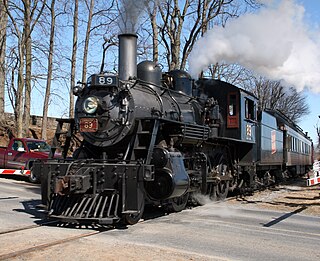
Under the Whyte notation for the classification of steam locomotives, 2-6-0 represents the wheel arrangement of two leading wheels on one axle, usually in a leading truck, six powered and coupled driving wheels on three axles and no trailing wheels. This arrangement is commonly called a Mogul.
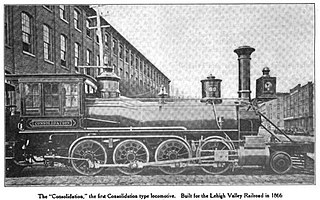
Under the Whyte notation for the classification of steam locomotives, 2-8-0 represents the wheel arrangement of two leading wheels on one axle, usually in a leading truck, eight powered and coupled driving wheels on four axles, and no trailing wheels. In the United States and elsewhere, this wheel arrangement is commonly known as a Consolidation, after the Lehigh and Mahanoy Railroad’s Consolidation, the name of the first 2-8-0.
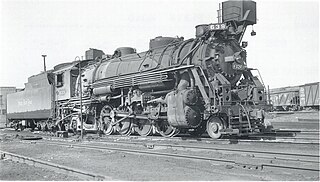
Under the Whyte notation for the classification of steam locomotives, 2-8-2 represents the wheel arrangement of two leading wheels on one axle, usually in a leading truck, eight powered and coupled driving wheels on four axles and two trailing wheels on one axle, usually in a trailing truck. This configuration of steam locomotive is most often referred to as a Mikado, frequently shortened to Mike.

The first Locomotives of the Great Western Railway (GWR) were specified by Isambard Kingdom Brunel but Daniel Gooch was soon appointed as the railway's Locomotive Superintendent. He designed several different 7 ft 1⁄4 in broad gauge types for the growing railway, such as the Firefly and later Iron Duke Class 2-2-2s. In 1864 Gooch was succeeded by Joseph Armstrong who brought his standard gauge experience to the workshops at Swindon. To replace some of the earlier locomotives, he put broad gauge wheels on his standard gauge locomotives and from this time on all locomotives were given numbers, including the broad gauge ones that had previously carried just names.

The Great Western Railway Iron Duke Class 4-2-2 was a class of 7 ft 1⁄4 in broad gauge steam locomotives for express passenger train work.
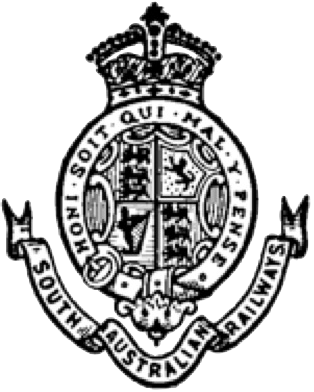
South Australian Railways (SAR) was the statutory corporation through which the Government of South Australia built and operated railways in South Australia from 1854 until March 1978, when its non-urban railways were incorporated into Australian National, and its Adelaide urban lines were transferred to the State Transport Authority.

The South Australian Railways 620 class was a class of 4-6-2 steam locomotives operated by the South Australian Railways.

Gauge conversion is the changing of one railway track gauge to another.

The South African Railways Class 16E 4-6-2 of 1935 is a class of passenger steam locomotive.

The South African Railways Class 16B 4-6-2 of 1917 was a steam locomotive.
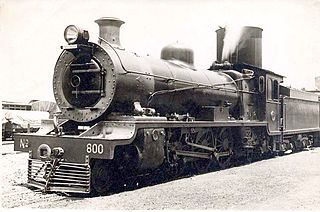
The South African Railways Class 16 4-6-2 of 1914 was a steam locomotive.
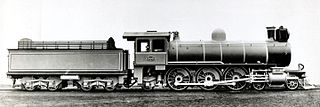
The South African Railways Class 9 4-6-2 of 1904 was a steam locomotive from the pre-Union era in Transvaal Colony.

The South African Railways Class 5A 4-6-2 of 1903 was a steam locomotive from the pre-Union era in the Cape of Good Hope.

The South African Railways Class NG1 0-4-0T of 1900 was a narrow-gauge steam locomotive from the pre-Union era in Transvaal.